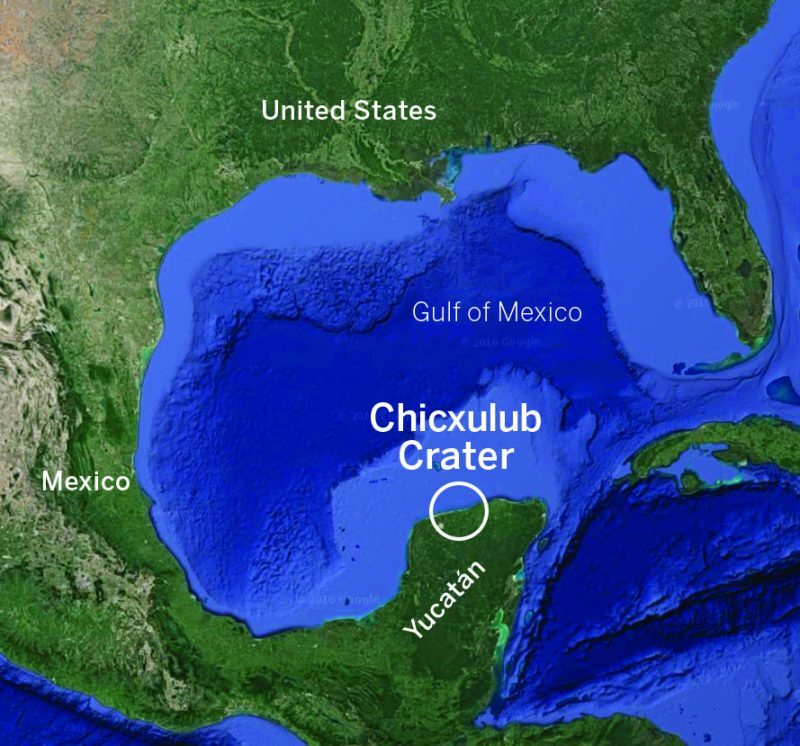17.08.2024
A new chemical analysis confirms the Chicxulub impactor was a fragile type of asteroid that formed in the outer solar system, unlike several other ancient impactors.

Some 66 million years ago, a roughly 10-kilometer-wide asteroid slammed into what today is the Yucatán Peninsula in Mexico. The debris thrown into Earth’s skies would have plunged our planet into a chilly gloom, deadly for the photosynthetic life that formed the base of the food chain.
Scientists still debate whether this event was solely responsible for the mass extinction of at least 60% of Earth’s species (including the dinosaurs), or whether it partnered with a climate catastrophe caused by volcanic eruptions that flooded India at the same time, or whether the volcanic calamity had already sealed the dinos’ doom before the asteroid hit.
But regardless, the Chicxulub impact certainly left its mark. In addition to a 200-km-wide scar along the Mexican coastline, the event left a thin layer of clay in the global sediment record. Previous studies of this layer have found rare elements best explained as asteroid debris, particularly a type of asteroid called a carbonaceous chondrite.
Carbonaceous chondrites are dark, primitive objects — some of the most primitive stuff left in the solar system. They’re fairly fragile and formed in the outer solar system, but today they’re found throughout the asteroid belt between Mars and Jupiter.
Studies of other ancient impactors from the last several hundred million years have instead fingered stony asteroids, tougher objects that formed in the inner solar system and today dominate the inner asteroid belt. That would make Chicxulub a rarity.
Mario Fischer-Gödde (University of Cologne, Germany) and an international team of scientists have now taken another look and confirmed that Chicxulub really was a carbonaceous chondrite.
The team used ruthenium, one of the platinum-group elements that are found in meteoritic material but are rare on Earth. Bodies will have different proportions of ruthenium’s isotopes depending on where they formed in the solar system, with objects that formed closer to the Sun containing more Ru-102 and Ru-100 than those that coalesced farther out. Each meteorite group has its own “genetic fingerprint,” the authors explain in the August 16th Science. So by measuring the impactors’ isotopic ratios, scientists can determine where the body formed.
The researchers looked at ruthenium levels in three samples from the Chicxulub sediment layer in Europe, as well as samples from five other impact structures with ages between 36 to 470 million years from around the world. They also looked at samples of a far older layer of impact debris from South Africa. This layer of tiny spheres of melted material formed between 3.5 and 3.2 billion years ago — the oldest evidence we have of large asteroids pelting our planet.
All samples had ruthenium levels distinct from Earth’s and matched different types of meteorites (and, therefore, asteroids). Chicxulub stood out as the lone carbonaceous chondrite. Importantly, it’s not a match for a specific type of carbonaceous chondrite known as CI. CI meteorites are thought to be similar in composition to comet nuclei. Some scientists have suggested that Chicxulub could have been a comet, although that theory was on shaky ground. If CI chondrites really are comet proxies, then the comet theory is out, the authors write.
The other five impactors are indeed stony asteroids. The ancient spherules are more complicated: The ruthenium levels favor stony asteroids, but previous results using chromium exclude that. The mystery impactors that created the spherules might instead have been carbonaceous. They could be the vestiges of Earth’s final stages of growth, the authors note.
The study is excellent and the first to use ruthenium to identify the Chicxulub impactor’s origin, says Honami Sato (Kyushu University, Japan), who has worked extensively on Chicxulub but was not involved with the current study. Scientists have previously used chromium for this purpose, but ruthenium is more resilient against terrestrial contamination or modification by the impact process, both Sato and Fischer-Gödde explain.
About 80% of known meteorites are stony, whereas carbonaceous fragments are rare. “I think our data for terrestrial impact structures mirrors this evidence from the meteorite record quite well,” Fischer-Gödde says. However, that doesn’t mean the same was true throughout Earth’s history, he cautions.
In fact, a 2021 study looked at the dynamics of which kinds of big asteroids would make it to Earth. The results suggested that about half of the whoppers that hit us may have been dark, primitive objects like Chicxulub.
For now, scientists don’t have evidence for other large, carbonaceous impactors like Chicxulub and whatever made the ancient spherules, Fischer-Gödde says. “But we will keep on searching.”
Given this result, researchers can also explore how different compositions might change an impactor’s effect on the global environment and ecosystem, Sato notes.
Quelle: Sky&Telescope
